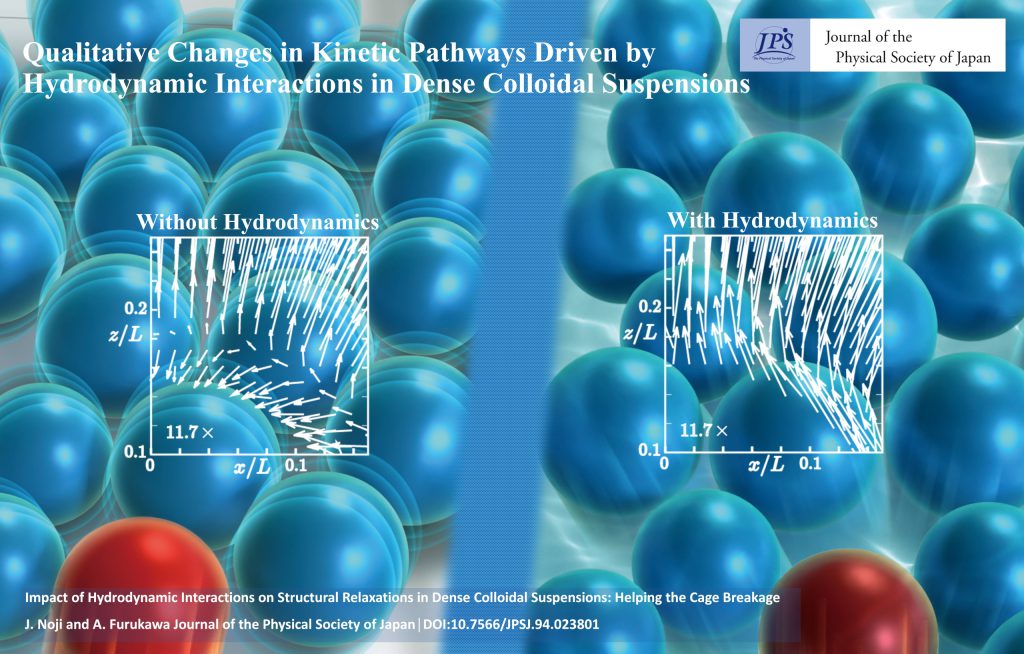Qualitative Changes in Kinetic Pathways Driven by Hydrodynamic Interactions in Dense Colloidal Suspensions
© The Physical Society of Japan
This article is on
Impact of Hydrodynamic Interactions on Structural Relaxations in Dense Colloidal Suspensions: Helping the Cage Breakage
(JPSJ Editors' Choice)
J. Phys. Soc. Jpn.
94,
023801
(2025)
.
Even in dense colloidal suspensions, where long-range hydrodynamic interactions are screened, near-field hydrodynamic interactions qualitatively influence the selection of kinetic pathways.

Colloidal suspensions, in which particles ranging from tens of nanometers to a few microns are dispersed in a liquid, are the basis of many industrial applications, including paints, foods, cosmetics, and pharmaceuticals. Their macroscopic dynamic behavior, especially under external flows or stresses, is strongly influenced by the microscopic motion of the suspended particles and the interactions among them. Hydrodynamic interactions (HIs), which are mediated by solvent flows, often play a crucial role.
In dilute suspensions, HIs are well described by the Oseen tensor, which captures long-range interactions that decay as 1/r,where r is the interparticle distance. However, as the concentration increases, particle crowding progressively screens these long-range interactions. Therefore, based on the longstanding assumption that HIs can be effectively neglected in sufficiently dense systems, Brownian dynamic simulations that ignore solvent-mediated hydrodynamic effects have been used to model the dynamics of concentrated suspensions. However, the assumption has not been sufficiently validated.
In this study, comparative numerical simulations were conducted for a densely packed colloidal suspension, almost in the supercooled regime, with and without HIs. The inclusion of HIs significantly accelerated relaxation dynamics, representing not only a quantitative shift in the timescale but also a qualitative change in the underlying kinetic pathways.
In highly concentrated systems, particles are confined in “cages” formed by neighboring particles, undergoing extended localized rattling. Without HIs, a probe particle attempting to move forward directly pushes against its nearest neighbors (ahead of the probe), which then pushes the next layer of particles. In turn, the outer particles exert pushback forces on the inner layers, and subsequently on the probe particle. These interactions induce an elastic response that restores the particle to its original position, reinforcing the cage effect.
In contrast, with HIs, the motion of the probe particle first pushes the surrounding solvent, generating solvent flows that induce motion in neighboring particles via lubrication forces. These neighbors, in turn, further drive the solvent flows, producing a consecutive propagation of flow-induced motion. This solvent-mediated pathway suppresses the elastic restoration response and weakens the cage confinement, thereby facilitating more cooperative particle rearrangements and accelerating structural relaxation. These results demonstrate that near-field HIs can propagate their influence over substantial distances through dynamic coupling between the particles and solvent. Thus, HIs can play a crucial role even in highly dense systems.
This study re-examines the longstanding assumption that HIs are effectively negligible in dense suspensions and highlights their substantial impact on dynamic behavior. This emphasizes the need to reconsider solvent-mediated HIs, particularly when designing materials and technologies based on dense colloidal suspensions.
(written by Akira Furukawa on behalf of all authors)
Impact of Hydrodynamic Interactions on Structural Relaxations in Dense Colloidal Suspensions: Helping the Cage Breakage
(JPSJ Editors' Choice)
J. Phys. Soc. Jpn.
94,
023801
(2025)
.
Share this topic
Fields
Related Articles
-
Overcoming Phase Transitions for Faster Quantum Annealing
Statistical physics and thermodynamics
2025-3-27
This study presents an innovative method to address the problem of phase transitions in quantum annealing, resulting in an exponential speedup of the process.
-
Exploring the Vibrant Interplay of Machine Learning and Physics
Cross-disciplinary physics and related areas of science and technology
Electron states in condensed matter
Elementary particles, fields, and strings
Mathematical methods, classical and quantum physics, relativity, gravitation, numerical simulation, computational modeling
Statistical physics and thermodynamics
Superconductivity
2025-3-13
This Journal of the Physical Society of Japan Special Topics edition explores how physics and machine learning complement each other and can solve unresolved problems in physics.
-
Bayesian Insights into X-ray Laue Oscillations: Quantitative Surface Roughness and Noise Modeling
Measurement, instrumentation, and techniques
Structure and mechanical and thermal properties in condensed matter
2025-2-14
This study adopts Bayesian inference using the replica exchange Monte Carlo method to accurately estimate thin-film properties from X-ray Laue oscillation data, enabling quantitative analysis and appropriate noise modeling.
-
Hyperuniform and Multifractal States in Bosonic Quasicrystalline Systems
Statistical physics and thermodynamics
Structure and mechanical and thermal properties in condensed matter
2025-2-10
Quantum states can be categorized as hyperuniform or multifractal based on electronic characteristics. This study demonstrates that bosonic quasicrystalline systems exhibit hyperuniform or multifractal quantum states.
-
Exploring Materials without Data Exposure: A Bayesian Optimizer using Secure Computation
Cross-disciplinary physics and related areas of science and technology
Measurement, instrumentation, and techniques
2025-2-6
Secure computation allows the manipulation of material data without exposing them, thereby offering an alternative to traditional open/closed data management. We recently reported the development of an application that performs Bayesian optimization using secure computation.




